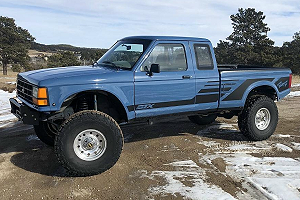- Joined
- Sep 26, 2011
- Messages
- 19
- Reaction score
- 2
- Location
- Southern California
- Vehicle Year
- 2002
- Make / Model
- Ford
- Transmission
- Automatic
A nasty little device. I was throwing a P0340 (Camshaft Position Sensor Fault) and the truck was barely drivable, this is a 2002 Ranger Edge with a 3.0. I parked it and ordered up a Motorcraft synchro, got home at eight and finished about nine.
For those unaware, this is notorious for failing in the Ranger (Post '95) and the best case scenario when it does is cause performance issues, the worst case is it destroys your engine. The shaft running down this is what drives your oil pump and it's being handled by a gear spot welded to it. In my case, the shaft had about 3/4" of play and the gear was severely worn to an almost razor like edge because of the float in the main shaft. This is what does it. As the bushings wear, the softer metal gear is allowed to float against the harder cam, wearing the rectangular gear teeth into more of a sharpened oval shape. This dumps a bunch of metal in your engine and starts a snowball effect. Had this gear failed, the engine would have likely quit but not before it was starved of oil and seized.
If you're over 70K in your truck, change it, it takes longer to clean up than the project does. I got a Motorcraft CPS for $165 but they will give me $50 for the core. You can pick up a reman CPS for about $100 out the door or $50 with a core. There are two types, "With Step Up" and "Without Step Up". This refers to the connector type. All EDGE 3.0's are "Without...". You can either pull your sensor before picking up a new one or just buy the "Without"...they work on everything.
Pull the negative.
The CPS is at the rear of the block, on top.
Two 7/16 bolts hold the sensor to the the synchro, remove these before disconnecting the harness. Pull the sensor off and remove harness - it's a tab release.
Mark the position of the shaft vane onto the manifold with a grease pencil or marker. The alignment tool and the TDC method is pointless, these teeth take a big bite, you're either off terribly or right on. Mark the body position.
The hold down bolt is behind and slightly to the passengers side of the shaft centerline. It's a 1/2" socket on a slight angle back.
Remove old one. Curse it and point while saying things like, "Look how bad this is". Then drop nothing in that hole.
Cover the new one in oil, from o-ring down. Lucas additive.
Drop in CPS. It will self align with oil pump shaft. It's a spiral type gear and the pitch dictates a one tooth clockwise jump. Aim for one back - for six o'clock shoot for five.
Your shaft vane now in place, align CPS body to mark.
Once it's aligned and fully seated against the block, insert the 1/2" hold down bolts.
Connector sensor to wiring harness and reseat onto CPS, tighten two 7/16" bolts.
Reconnect negative.
When you start it, just let it idle. Don't do anything punchy until that CPS can saturate itself with oil. Ford dealer man says to let it go for about a minute like that while the computer makes tiny adjustments to the now consistent firing timing.
Result was a cleared P0340 code and a completely different engine.
The bonus to all of this is that in the process of tracking down this problem, I replaced the ICV, the MAF sensor, the plugs, plug wires, coil, fuel filter, throttle body, cleaned air box...and now, finally, I own a code reader.
Happy Wrenching.
For those unaware, this is notorious for failing in the Ranger (Post '95) and the best case scenario when it does is cause performance issues, the worst case is it destroys your engine. The shaft running down this is what drives your oil pump and it's being handled by a gear spot welded to it. In my case, the shaft had about 3/4" of play and the gear was severely worn to an almost razor like edge because of the float in the main shaft. This is what does it. As the bushings wear, the softer metal gear is allowed to float against the harder cam, wearing the rectangular gear teeth into more of a sharpened oval shape. This dumps a bunch of metal in your engine and starts a snowball effect. Had this gear failed, the engine would have likely quit but not before it was starved of oil and seized.
If you're over 70K in your truck, change it, it takes longer to clean up than the project does. I got a Motorcraft CPS for $165 but they will give me $50 for the core. You can pick up a reman CPS for about $100 out the door or $50 with a core. There are two types, "With Step Up" and "Without Step Up". This refers to the connector type. All EDGE 3.0's are "Without...". You can either pull your sensor before picking up a new one or just buy the "Without"...they work on everything.
Pull the negative.
The CPS is at the rear of the block, on top.
Two 7/16 bolts hold the sensor to the the synchro, remove these before disconnecting the harness. Pull the sensor off and remove harness - it's a tab release.
Mark the position of the shaft vane onto the manifold with a grease pencil or marker. The alignment tool and the TDC method is pointless, these teeth take a big bite, you're either off terribly or right on. Mark the body position.
The hold down bolt is behind and slightly to the passengers side of the shaft centerline. It's a 1/2" socket on a slight angle back.
Remove old one. Curse it and point while saying things like, "Look how bad this is". Then drop nothing in that hole.
Cover the new one in oil, from o-ring down. Lucas additive.
Drop in CPS. It will self align with oil pump shaft. It's a spiral type gear and the pitch dictates a one tooth clockwise jump. Aim for one back - for six o'clock shoot for five.
Your shaft vane now in place, align CPS body to mark.
Once it's aligned and fully seated against the block, insert the 1/2" hold down bolts.
Connector sensor to wiring harness and reseat onto CPS, tighten two 7/16" bolts.
Reconnect negative.
When you start it, just let it idle. Don't do anything punchy until that CPS can saturate itself with oil. Ford dealer man says to let it go for about a minute like that while the computer makes tiny adjustments to the now consistent firing timing.
Result was a cleared P0340 code and a completely different engine.
The bonus to all of this is that in the process of tracking down this problem, I replaced the ICV, the MAF sensor, the plugs, plug wires, coil, fuel filter, throttle body, cleaned air box...and now, finally, I own a code reader.
Happy Wrenching.













